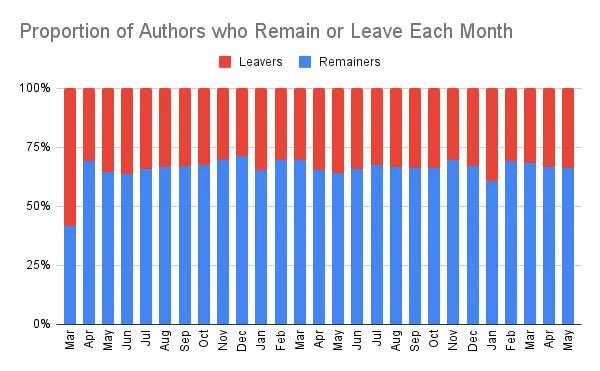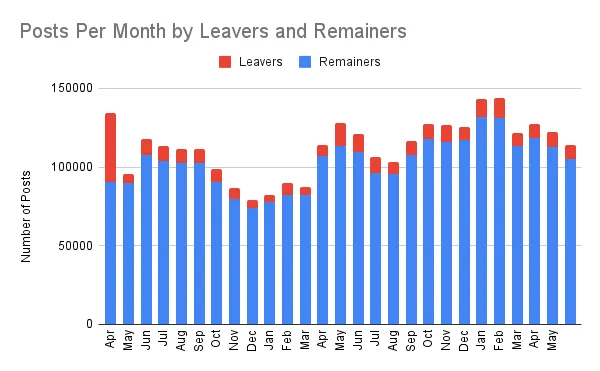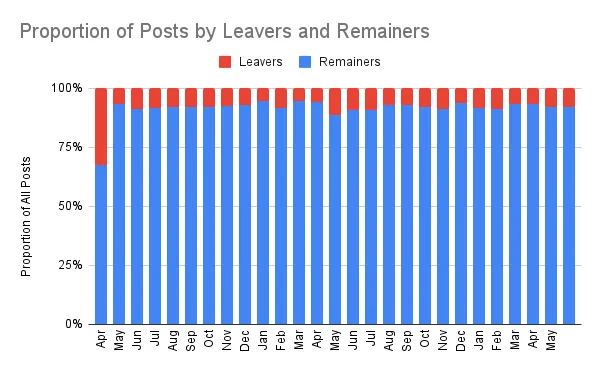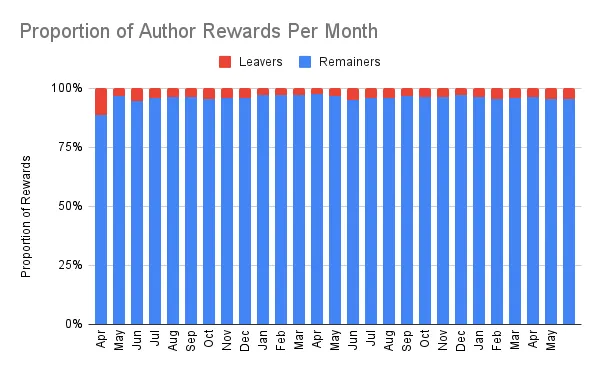This is the fourth post in a series exploring user retention on Hive. In those posts I explored user cohorts and how many of them continue posting actively year after year. I also explored how much those cohorts are earning in rewards, and how the ease of breaking in and making rewards on Hive has changed over the years.
Join for the Rewards, Stay for the Rewards?
Today I want to answer the question in the title, and although that would require much more rigor than it takes to make a blog post in a few hours, I will at least explore and present the data as best I can. The results may surprise you, they certainly surprised me.
First we have to define what it means to leave. Outside of death or loss of account keys, usually there is nothing preventing a user who has "left" the network from coming back at any time. So for this purpose, I will define "leaving" as someone who actively made a post on one month, and then did not make any post on the next month. The opposite of a leaver is a remainer, who makes a post in one month and proceeds to make at least one on the next month as well. Sorry to all British readers for the choice of terms.
Here is the chart of posts made by "leavers" and "remainers" as defined above, since the Hive exodus hard fork of March 2020. June 2022 is removed because July has only started.

There is not much insight that pops out immediately, aside from the obvious number who did not transition from Steem. Here is a chart which shows the proportion each month.

The most remarkable thing is the consistency. Aside from the exodus fork, the number of authors who remain month on month never exceeds 70%, but never drops below 60% either. Hive consistently loses 30-40% of active authors each month.
Activity
Ok, so let's try and distinguish what differences there are between those who leave and those who stay. I would expect that remainers are more likely to be long time users, who are more likely to make more posts each month.

Indeed, we can see that those who remain are also making a larger number of posts.

The proportion chart again shows it is fairly consistent - outside of the fork leavers create at least 5% and at most 11% of all posts.
Rewards
I would also expect that those who remain are the authors making rewards, so let's take a look.

Indeed, the proportion is even lower for rewards than it is for number of posts.

5% is the very most that leavers get per month.
How about rewards per post?

Aha! This might be the first really interesting chart here. The previous charts all showed only one story: consistency. 30% of users leave consistently each month. Users who leave make a consistent proportion of posts and they get a consistent proportion of rewards. But one thing is NOT consistent: how much they are paid per post per month. In late 2021, Hive was paying out several times what it was paying a year earlier - yet the people who left were being paid more than the people who stayed were being paid in 2020.
This seems to strongly suggest that absolute reward values are NOT what encourages people to leave or stay. If it was about absolute rewards, we would have higher proportions of users staying during the bull markets when everyone is earning more. That's not the case - authors appear to leave just as often when they're well rewarded - if anything they are slightly more likely to leave when they are receiving more rewards.
That's not to say author rewards don't matter for user retention, but if they do, it would be some other aspect than the absolute amount. For example, it could come down to expectations vs reality, or making more rewards than other users, or making it to the trending page etc.
I was planning to explore some more aspects, such as the account age of leaving vs remaining authors, as well as number of votes and comments, but I will leave it at this for now. Thanks for reading if you have gotten this far. All data in this post was gathered using @hivesql.